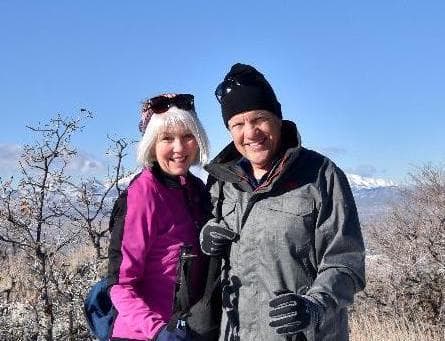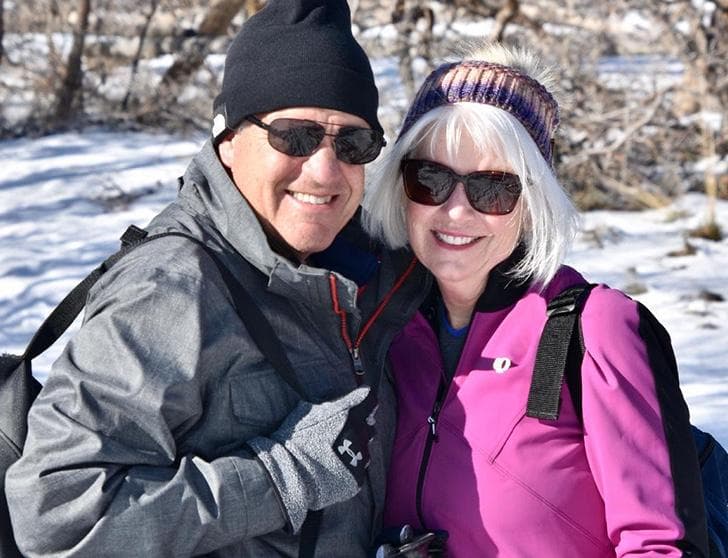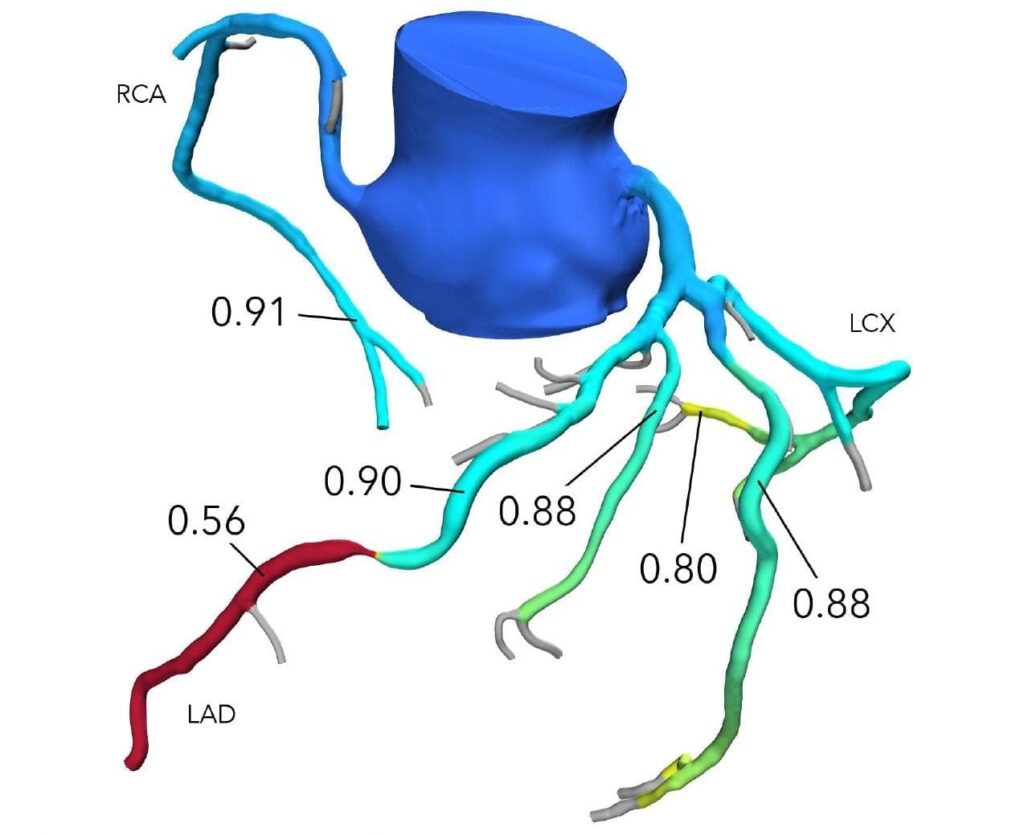Heart disease is the leading cause of death in the United States1, but many healthy and physically active families do not expect heart disease to affect them. Mary Anne and Rod Norling experienced firsthand how important it is to take symptoms seriously and seek proper care.
“My family had some history of heart issues, but I had thought that I had done well to alleviate my risks,” said Mary Anne. The couple had been avid bikers, hikers, skiers and boaters. Combining their regular active lifestyle with healthy weight, the Norlings didn’t seem to be at a high risk of being two of the over 650,000 people in the United States that die from coronary artery disease each year2.
However, while on vacation in Lake Tahoe, California in 2012, Mary Anne suffered a heart attack. After being taken to the hospital, she received two stents in her right coronary artery. The event happened after about a year of her experiencing mild to moderate left arm discomfort and lagging endurance.

Mary Anne N.
“My family had some history of heart issues, but I had thought that I had done well to alleviate my risks.”

“Doctors I talked to during that time before my heart attack weren’t able to help,” said Mary Anne. “Perhaps it was because of my fitness, or because of the unfortunate tendency not to take women’s pain and discomfort as seriously as men’s, but I wasn’t getting the help that I needed.”
Even after her heart attack, issues persisted. Mary Anne experienced mild chest pain symptoms, causing doctors to recommend anti-anxiety treatments and even suggesting her struggles were all “in her head”. She then came under the care of cardiologist Dr. Frederick St. Goar, who listened and adjusted her medications to help eliminate the discomfort she was feeling.
In 2019, her symptoms became more severe. Dr. St. Goar ordered a CT and HeartFlow Analysis, which developed a 3D blood flow model of her coronary arteries. Using that model, Dr. St. Goar was able to diagnose an important new blockage on the left side of her heart, and subsequently placed another stent.
Shortly thereafter, Rod began having difficulty exercising and experienced shortness of breath. He dismissed the issues as perhaps related to a rib injury, but pre-op work for back surgery in 2021 showed irregularities on his ECG test results.

Rod N.
“After being with my wife during her experience, I knew that I needed to take my own issues seriously.”

“After being with my wife during her experience, I knew that I needed to take my own issues seriously,” said Rod. “I went to Dr. St. Goar to help make sure we caught problems before they got worse.”
In addition to his symptoms, a calcium scoring test indicated that there might be coronary artery disease, so a CT and HeartFlow Analysis were ordered. These helped Dr. St. Goar non-invasively identify a significant blockage in one of the main arteries supplying blood to Rod’s heart, a location sometimes referred to as the “widow-maker”. A stent was placed which may have saved his life.
The HeartFlow Analysis helped Dr. St. Goar pinpoint coronary disease in both Rod and Mary Anne and get them the necessary treatment as soon as possible, a critical step in helping them feel better and preventing more serious complications in the future.
“Even active individuals can have underlying issues, and if something feels off, they need to be comfortable speaking up,” said Dr. Frederick St. Goar, MD, FACC. “It’s imperative that patients advocate for their own health, and partner with health care providers to make sure they get the care they deserve.”

February’s annual American Heart Month can serve as a great reminder for individuals to not only make lifestyle decisions to reduce the risk of heart disease, but also look for screening options to make sure heart disease is caught as early as possible. Learn more about potential options.
View additional patient stories or view additional resources >>




The information provided by the HeartFlow Analysis is intended to be used in conjunction with the patient’s clinical history, symptoms, and other diagnostic tests, as well as the clinician’s professional judgement. The HeartFlow Analysis may not be appropriate for all patients. See indications for use for more information. The HeartFlow Analysis, featuring the FFRCT Analysis, RoadMapTM Analysis, Plaque Analysis, and HeartFlow Planner, has received FDA Clearance in the United States of America. The FFRCT Analysis and HeartFlow Planner are CE Marked in Europe and the United Kingdom and approved in Japan and Canada. The HeartFlow Analysis, featuring FFRCT Analysis, RoadMapTM Analysis, Plaque Analysis, and HeartFlow Planner, is commercially available in the United States. The FFRCT Analysis and HeartFlow Planner are commercially available in the United Kingdom. The FFRCT Analysis is also commercially available in Europe, Japan, and Canada.
© 2024 HeartFlow, Inc. | HeartFlow and the HeartFlow logo are registered trademarks of HeartFlow, Inc. Additionally, RoadMap is claimed as a trademark of HeartFlow, Inc. www.heartflow.com | 331 E Evelyn Ave, Mountain View, CA 94041
*Required fields
If you would like to request to have the HeartFlow Analysis available at a location near you, please submit your information below with details of the institution. We will share this information with the institution, but it will not guarantee HeartFlow will become available.
*Required fields
オンライン提出フォームから研究助成金を申請してください。
HeartFlow FFRCT 分析は、有資格の臨床医による臨床的に安定した症状のある冠状動脈疾患患者への使用を目的とした個別化された心臓検査です。 HeartFlow Analysis によって提供される情報は、資格のある臨床医が患者の病歴、症状、その他の診断検査、および臨床医の専門的判断と組み合わせて使用することを目的としています。
ハートフロー分析に関する追加の適応情報については、次のサイトをご覧ください。www.heartflow.com/indications.
さらに質問がある場合は、このメッセージを閉じてフォームに記入するか、サポート チームにお電話ください。: 877.478.3569.
The HeartFlow FFRCT Analysis is a personalized cardiac test indicated for use in clinically stable symptomatic patients with coronary artery disease by qualified clinicians. The information provided by the HeartFlow Analysis is intended to be used by qualified clinicians in conjunction with the patient’s history, symptoms, and other diagnostic tests, as well as the clinician’s professional judgement.
For additional indication information about the HeartFlow Analysis, please visit www.heartflow.com/indications.
If you have additional questions, close out of this message to complete our form or call our support team: 877.478.3569.Please use our online submission form on the Clinical Research Page to apply for research grants.
Thank you for your interest!

Executive Vice President and Chief Medical Officer
Campbell brings a wealth of experience to HeartFlow, where he serves as the Chief Medical Officer. Prior to joining HeartFlow, he was the Chief Scientific Officer and Global Head of Research and Development at Cordis Corporation, Johnson & Johnson, where he was responsible for leading investments and research in cardiovascular devices. Prior to Cordis, he was Associate Professor of Medicine at Harvard Medical School and the Harvard-M.I.T. Division of Health Sciences and Technology, and Director of the Cardiac Catheterization and Experimental Cardiovascular Interventional Laboratories at Brigham and Women’s Hospital. He served as Principal Investigator for numerous interventional cardiology device, diagnostic, and pharmacology trials, is the author of numerous journal articles, chapters, and books in the area of coronary artery and other cardiovascular diseases, and was the recipient of research grant awards from the NIH and AHA.
He received his A.B. from Harvard College and his M.D. from Harvard Medical School.